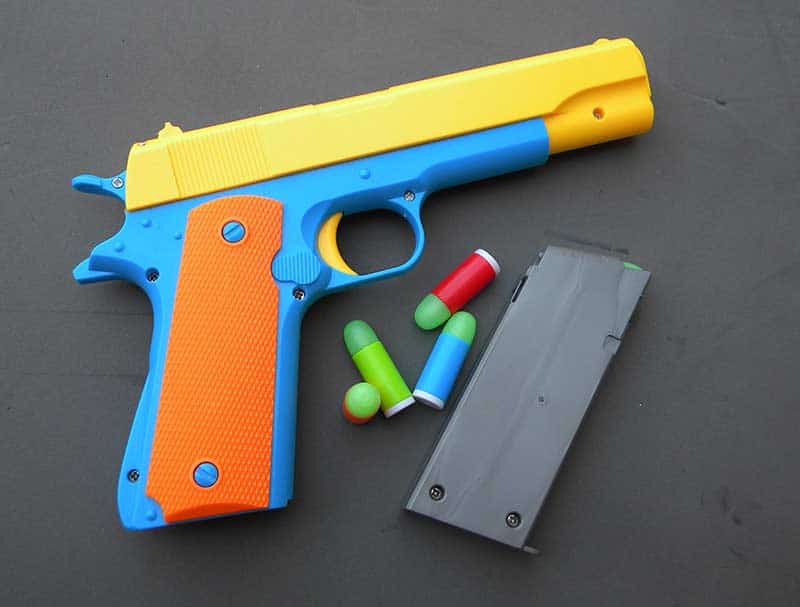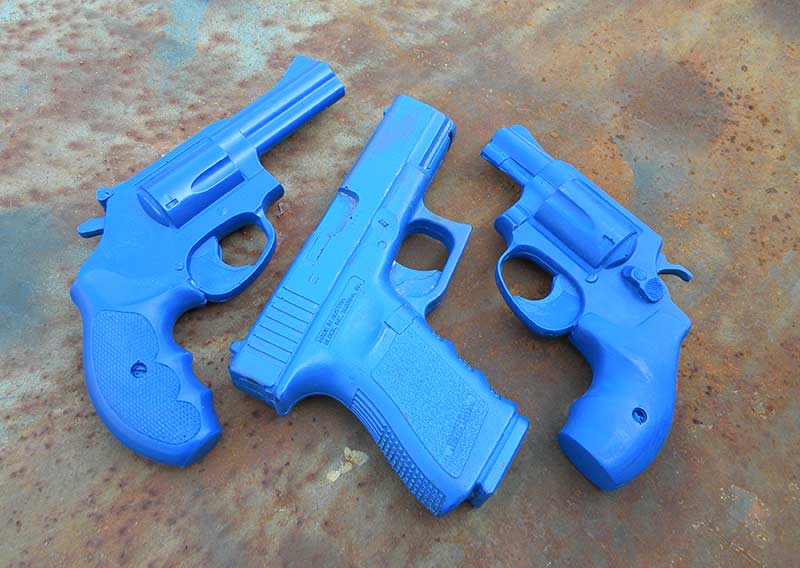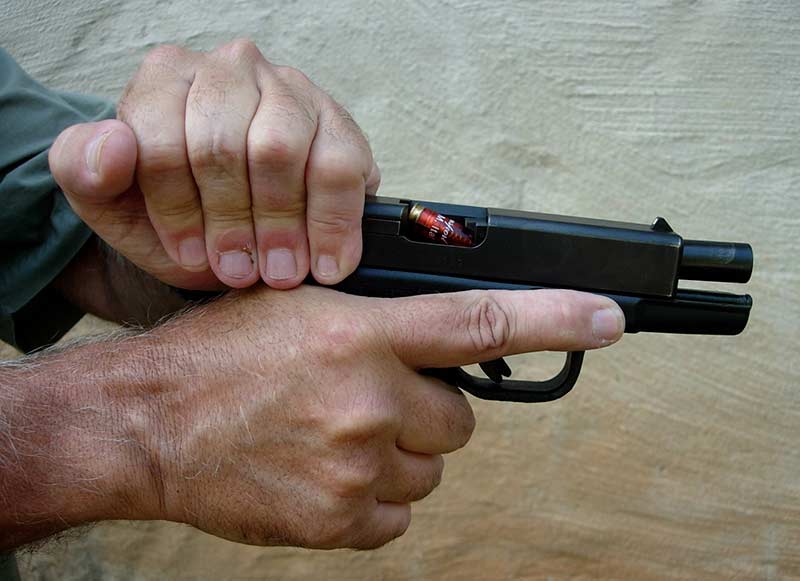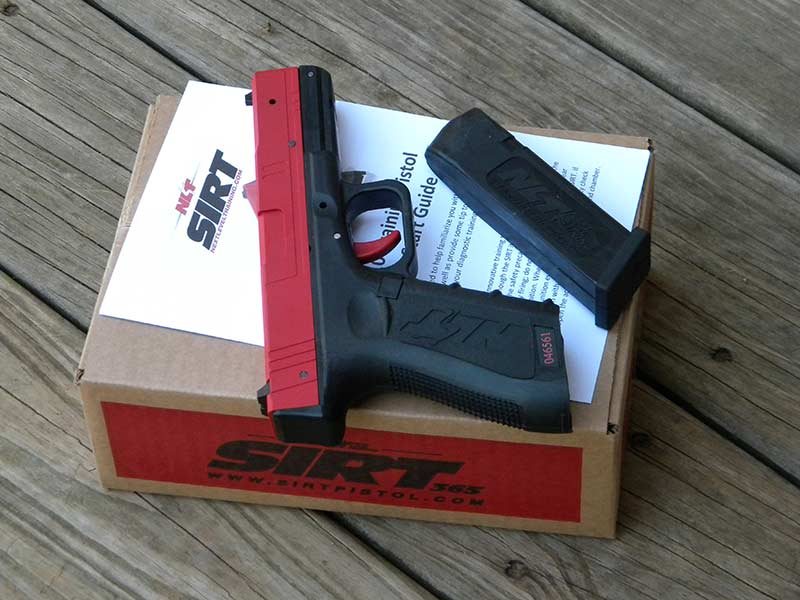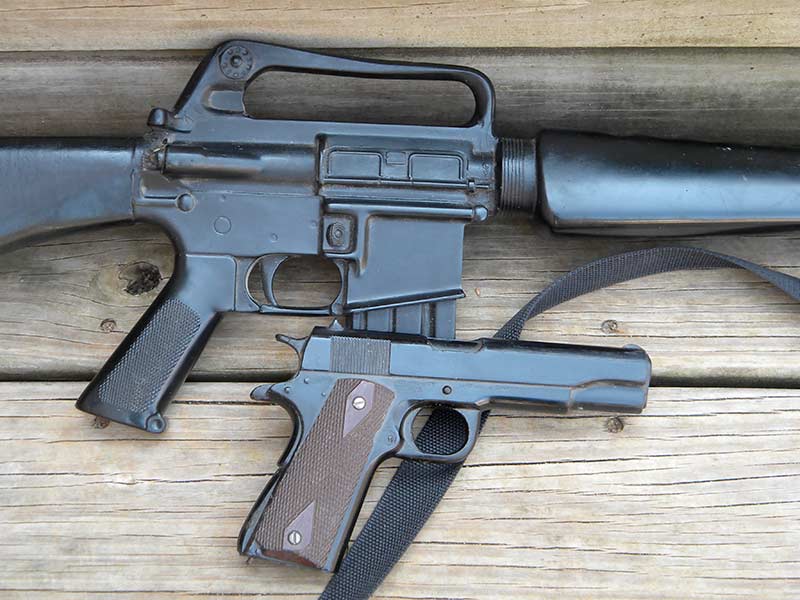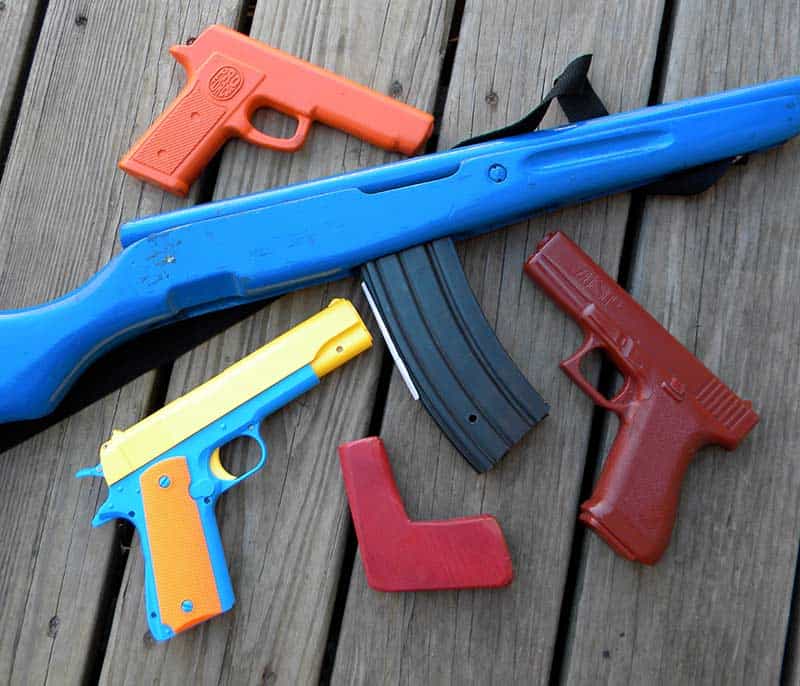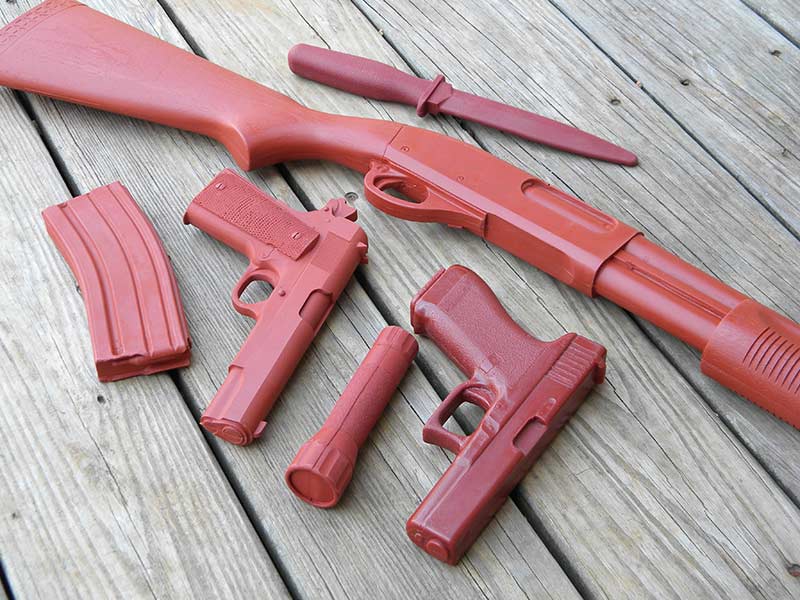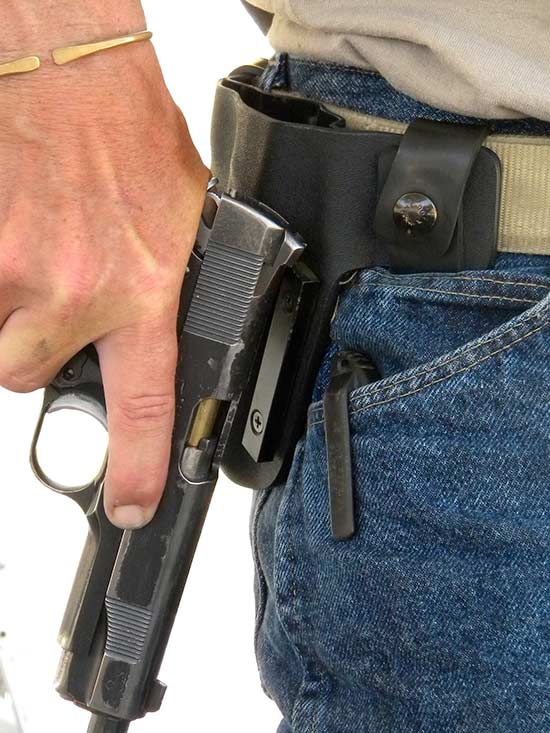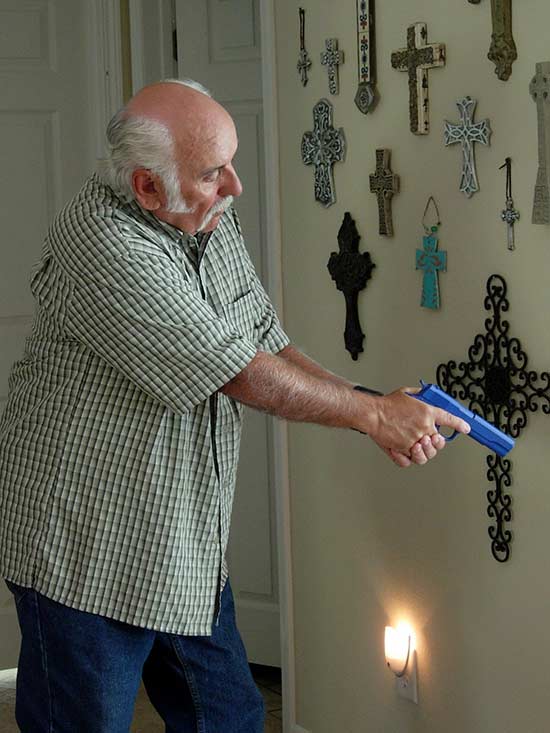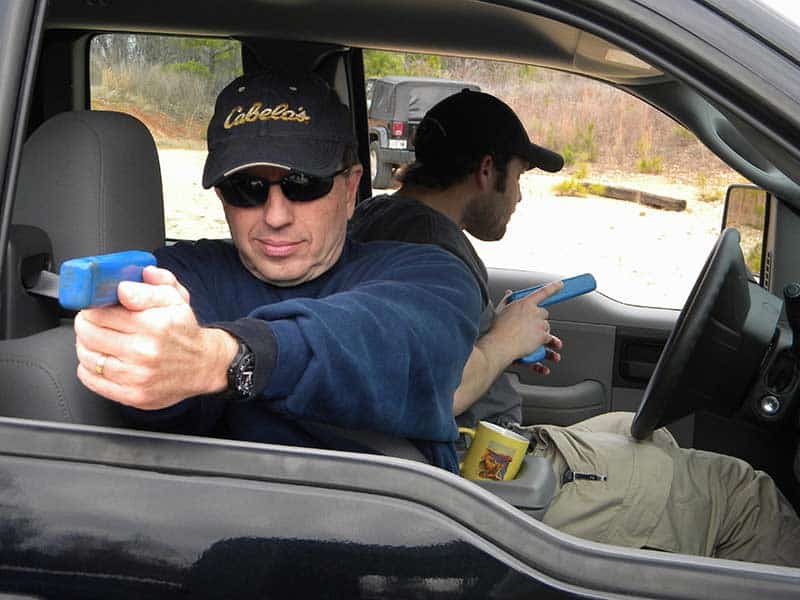Why Try Dry?
Because Home Practice With Dummy Guns and
Ammo is the Key to Concealed Carry Competence
Every once in awhile you see shooters who are squared away. When they draw their pistol, it’s clean and effortless and they manipulate it efficiently. It seems like they can hit anything. Well, the only thing separating you from them is practice. And you don’t have to go to the range or spend money on ammunition. You can get really good without ever firing a shot. How? Dry practice.
After attending training it takes practice to be able to apply your skills efficiently and on demand. Regardless of who you are, it takes several thousand repetitions to learn a skill. And the more complex the skill, the more practice necessary.
The best way to learn reloading is dry practice. The same thing applies to the majority of your “fighting” skills. With dummy weapons and ammo you can perform these repetitions at home, on your own schedule and safely.
Your initial investment to get set up for dry practice isn’t that much. Buying the training equipment is a one-time deal, as opposed to having to buy or reload ammo for every practice session. Timewise, everyone can afford 10 or 15 minutes a day practicing at home. Then you go to the range just to make sure the bullets are hitting where they are supposed to when you press the trigger.
The Accuracy Hang-Up
You actually learn more from dry practice than you do slinging lead downrange. On the range you’re working on stance, grip, manipulations and other fundamentals, but ultimately we all get caught up in the “where did the bullet go” thing. This distracts you from everything else because you’ve gotten wrapped around the axle about accuracy.
Actually, almost everyone shoots as accurately as everyone else. (Keep in mind we’re talking about people who practice). But there’s not a lot of practical difference between the guy who shoots every week and the guy who shoots once a month. The difference is in things like drawing the pistol, moving and using cover and reloading or clearing malfunctions. And these are the things you focus on during dry practice.
During dry practice you can focus on a few specific skills at a time — reloads while moving or getting to cover. The same goes for all your other skills. Once you’ve learned how to perform these actions you can apply them efficiently under any type circumstances.
Why Dummy Guns?
There are more and more people getting into the gun culture — especially for self-defense and concealed carry — who have never held a gun before. A lot of times these new people are extremely fearful of making a mistake, even with an instructor next to them saying, “Relax, I’m not going to let you make a mistake.”
Letting a new shooter handle a dummy pistol helps them develop safe gunhandling skills — properly gripping the pistol and keeping the index finger clear of the trigger and outside the triggerguard. As I tell all my new shooters, spending $40 for a dummy pistol is the best investment they can make. In my opinion it’s just as important as having the right holster and other related gear.
I initially thought by the time shooters get into mid- to advanced-level classes they’d know about dummy guns and their value. But this isn’t the case. Very few of them have dummy weapons to practice with. This is a shame because it usually means the only time they practice is when they go to the range. The problem here? Most ranges won’t allow you to work on moving, drawing the pistol or practicing a realistic “threat response.”
Take movement for example. Our natural response to danger is to freeze, hoping not to draw attention while we try figure out exactly what’s happening. But sometimes, by the time you determine exactly what’s going on, it’s too late to respond. When we decide to fight our instinct is to stay rooted to the ground, the way we would if we were fighting with clubs, rocks or knives, which are more instinctual.
But with firearms we can be moving away from the threat or toward cover and still be hitting the threat with accurate shots. But it takes a lot of practice to override this freeze instinct. Dummy weapons allow you to practice moving — which in most cases should be your initial response — and drawing the pistol while moving to cover.
Dummy guns are also great for modifying existing skills. It takes far more repetitions to modify something than it does in the beginning to learn a skill. Dummy weapons and ammo allow you to get in the repetitions necessary before going to live fire drills.
Regardless of your level of experience, dummy weapons and ammo are the way to learn, maintain and improve your concealed carry skills.
Not All Dummies Are Alike
Dummy guns come in a variety of styles. “Redneck” dummy guns are the ones I make myself. I trace the shape onto wood and cut ’em out. By using different thickness wood I can have a slim single-stack 1911 or a thicker, double-stack GLOCK. I sand and radius all the edges down smooth and spray bomb ’em a bright color to make sure they’re never confused with a real pistol.
For long guns I’ll get an old stock and attach a wooden dowel to it for a barrel. Mount up a sling and you’re good to go. SKS stocks are really cool because you can actually slip an AR magazine into them. The more realistic your training gun is, the better. For example, if you’re working with an AR prone, you need to get used to coping with the length of a 30-round magazine.
Some toy pistols work well for practice, especially with new shooters. For example, on Amazon I found a “1911” made of hard plastic with a slide that cycles and a removable magazine. It even fires the dummy rounds, although not with much force. This is a great way to teach new shooters the fundamentals of loading and unloading.
The next step up is “blue” or “red” guns. These hard plastic pistols and long guns are actual reproductions of real firearms. They fit your holster just like your carry pistol, and your grip is the same. Now you can safely practice drawing your pistol, working on your grip or stance and other carry skills. The key is getting in the repetitions necessary to apply these skills on demand and under stress.
On the upper end of practice pistols is Next Level Training’s SIRT pistols. When you touch the trigger, one laser shows you where the sights are aligned. Pressing the trigger fires another laser, which shows you where the bullet would hit. Then it has a trigger that “resets,” so you get to practice this part of the shot as well. They have a removable magazine, the same weight and feel of a real handgun, and an adjustable trigger so you can match it to that of your carry gun.
Another valuable practice tool are dummy rounds such as Precision Gun Specialties’ Saf-T-Trainers Dummy Rounds, which I get from Brownells. These can be used to practice reloads and malfunctions. You can also get snap caps, which have a brass base and a “primer” with a spring in front of it. Some people will make dummy rounds using real bullets and cases — without primer or powder — but I’ve always been leery of these because they look like live ammo, so it’s possible to get confused. There are dummy magazines for pistols and AR’s that have weight to them to replicate a loaded magazine.
How To Practice?
Handle everything as though it was the real deal, applying all the safety rules so you don’t develop any bad habits. Don’t spin your dummy pistol on your finger cowboy-style or flip it in the air performing “border shifts.”
When you’re using a dummy gun there’s no way you can make a mistake. Where you have to be really careful is when you’re using a real pistol with dummy training rounds for dry practice. First, make sure you have a backstop capable of stopping a round, just in case you make a mistake. There should be no live ammo anywhere near you, not even in the same room. And this is really important — once you’re done, you’re done. The people I know who have made mistakes with dry practicing, finished up, loaded their pistol and then decided to do “one more draw and press.”
With the training guns and dummy ammo, you work on the fundamentals such as drawing the pistol, moving and using cover. You practice single hand skills because hand and arm injuries are common in fights. It may be necessary to draw your handgun with only one hand/arm or the other. You drop your pistol (because this happens) and work on retrieving it efficiently, keeping your head and eyes up. Practice “ground fighting,” which is when you get knocked down, trip or fall due to an injury and are forced to fight from there, working back up to standing. In other words, all the things that might occur during an attack, and the coping techniques you can’t practice at a normal range.
You use the dummy ammo loaded into magazines to practice empty reloads or drills. I actually practice malfunctions more than empty reloads. For some reason most people don’t like to work on malfunctions. But if you look at the data, the number of shots most often fired in self-defense confrontations is 3 or 4. All our handguns hold more than this, even revolvers. So when you think about it, the chances of having to reload are much less than the possibility of having to clear a malfunction. And malfunctions are always unexpected. You know after you’re been firing awhile it’s about time to reload. A malfunction could pop up on the first, second or third round.
Also, don’t forget to practice on pressing the trigger. We tend to get so caught up in other techniques and tactics we neglect to practice the trigger press. Live fire doesn’t really count. When you press the trigger and the weapon fires you don’t see the “jerk” or anticipation. It shows up on target; typically low and left for a right-handed shooter. But people don’t see the dip because everything happens in a short span of time. I’ll have students do dry fire presses in the middle of live fire drills. They’ll anticipate, because it’s become a habit, and even when they know there’s no recoil coming the muzzle dips down when the trigger releases. Ultimately the goal is to have more dry presses than live ones with recoil. This develops the habit of pressing without any anticipation.
According to experts, 90 percent of your practice should be dry. Then all you have to do is go to the range and make sure you’re shooting accurately. But when you do get to the range, you’ll be amazed at the progress you’ve made. Think of this process as homework and study. Studying is your dry practice. Live fire drills are the test. During live fire you’ll always discover areas needing improvement. In fact, if you’re not making mistakes or finding areas in need of improvement, you’re probably not doing it right. Make notes so you practice these skills dry. Then you go to the range to see your improvement.
For concealed carry you must have the mandatory skills “pre-programmed.” The only way to get to this point is training, followed by plenty of practice. Again, the best way to get these necessary repetitions is dry practice. With a little investment and some time you can see a huge return. Self-defense is a serious subject and should be approached accordingly. If you are serious, then you’ve got to get the gear you need.
For More Info:
www.asp-usa.com
www.blueguns.com
www.nextleveltraining.com
www.brownells.com

